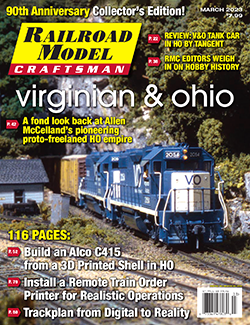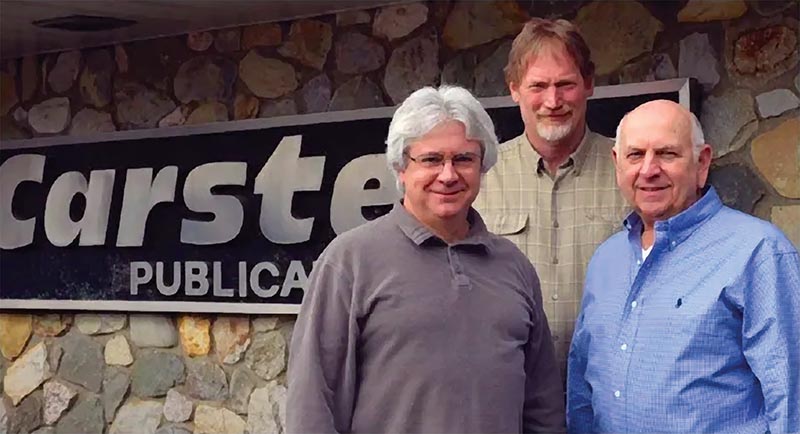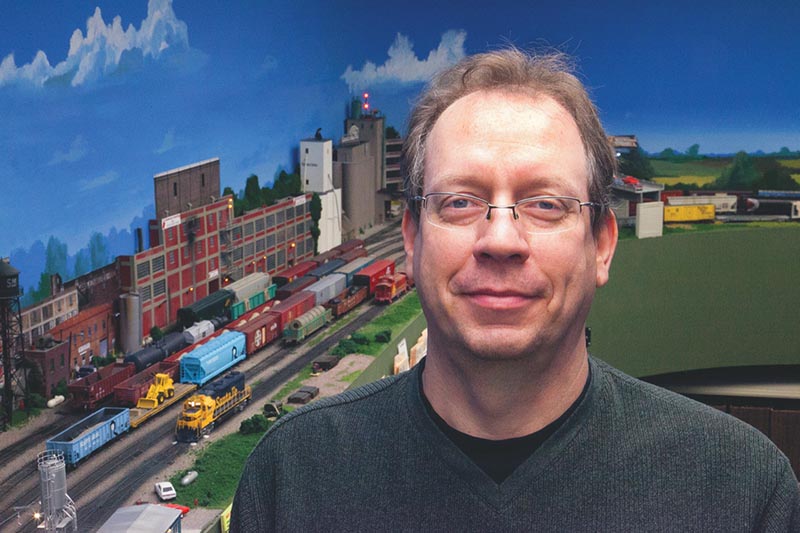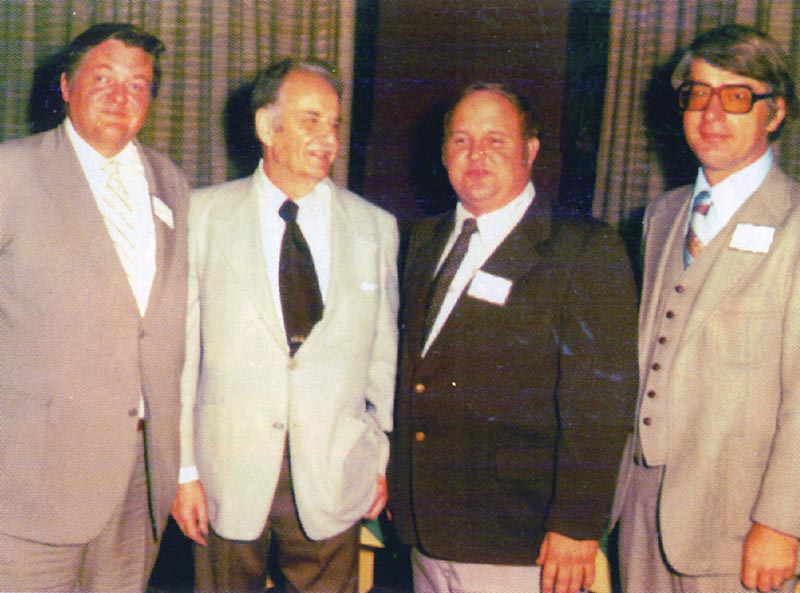 To celebrate our 90th year, I reached out to as many of our past editors as I could to get their unique Perspective on what changes they witnessed not only in the magazine, but in the hobby as a whole. —O.M.V.
To celebrate our 90th year, I reached out to as many of our past editors as I could to get their unique Perspective on what changes they witnessed not only in the magazine, but in the hobby as a whole. —O.M.V.
The Progressive 70s
I joined the Railroad Model Craftsman staff in January 1969 as associate editor. Hal Carstens was quite busy running a rapidly growing publishing company, so it soon became obvious that he was looking to me to line up the content, edit the material, and help art director Viola Kapps with page design. I soon took over the art director function as well, redrew many of “The Layout Doctor”’s (Bill Schopp’s) track plans, and for all practical purposes had complete editorial control of the magazine.
Two years later, contributor Jim Boyd joined the company to help produce our sister publication Flying Models. With his wealth of experience working on the Illinois Central and later with diesel manufacturer Electro-Motive, his prototype perspectives became valuable contributions to our model magazine. It wasn’t too long before Jim, ad manager Wayne Daniels, and I sensed something was up, and we guessed Hal was about to announce the launch of Railfan. Jim and I hustled to produce the first issue in secret, and by the time Hal called Jim into his office to make the big announcement, Jim was able to show him what we had lined up for issue No. 1 that was published in Winter 1974.
By then it had become obvious that Hal had “rail-banked” Jim for the day when he would eventually launch Railfan, but Jim also continued to make regular contributions to RMC. Interestingly, I was hired after stopping by RMC’s offices to propose a publication called “Railfan” to Hal in the fall of 1968. Hal grinned and pulled a file folder out of his desk marked “Railfan,” but he said the time wasn’t right. He was looking for an associate editor for RMC, however, so after discussing it with my wife, Judy, I took the job.
When I started at RMC, the magazine was 68 pages, two-color (black and one “spot” color), and had a circulation of around 48,000. But ahead were the dynamic 1970s and a fellow named Allen McClelland, who both Jim and I recognized early on as someone who was way ahead of the pack. I met Allen in the fall of 1970, and we discovered we were often on the same page. That led to some innovative articles such as running a fantrip with Nickel Plate Road 759 over the Virginian & Ohio and then the groundbreaking The V&O Story series in the late 1970s. My recently released Kalmbach Media book Allen McClelland and His Virginian & Ohio pays homage to “The Man Who Changed Everything.” It documents his leadership into linear trackplanning, walkaround command control, thinking “beyond the basement,” and so many other important aspects of scale model railroading that we take for granted today.
RMC had the first team of contributors during the 1970s: Bill Schaumburg (who later joined the staff in 1976 and became editor when I went to Bell Labs in 1981), Wayne Wesolowski, Doug Leffler, Don Fiehmann, Dave Frary and Bob Hayden, John Allen, David Barrow — I could continue on for several lines. Everyone seemed to sense the excitement that Jim Boyd and I felt about the potential of scale model railroading and wanted to be a part of it. Readership and advertising responded; I think circulation touched well over 100,000 — perhaps as high as 130,000 for peak winter issues — with the page count topping off around 160, all in glorious full color.
By 1973, we had outgrown the Arch Street offices in Ramsey, N.J., and Hal built a new modern office and warehouse building overlooking the Appalachian Trail in rural Sussex County. Judy and I built our new home near Newton to house our four children and what soon became the HO scale Allegheny Midland. That railroad occupied my time and our basement until the turn of the century when I decided it was time to honor a favorite prototype, the St. Louis Division of the Nickel Plate Road, which I model today.
The 1970s and early 1980s were a remarkable period in scale model railroading. I won’t try to pin down specific years, but we segued from dyed sawdust to ground foam, thanks mainly to Woodland Scenics; from lichen forest canopies to ground-foam-covered poly-fiberfill “puffballs,” thanks to Lee Riley at Bachmann and some experiments Don Cassler and I made with his material; and from fixed-position DC to walkaround command control, thanks to GE’s Astrac and offshoots thereof and then totally new approaches from innovators like Keith Gutierrez, Larry Keeler, and Abbott Lahti.
Brass locomotives had been hit-or-miss, especially for those non-collectors who operated them, but by the early 1980s, Key Imports was producing steam locomotives that were excellent in all respects. I still run a fleet of their Mikados and Berkshires and, with a few upgrades, consider them the best on my roster. Manufacturers were picking up on the desire for railroad-specific details on plastic models, although Life-Like’s (now Walthers’) popular Proto 2000 line wouldn’t debut until 1989, and resin craftsman kits like those pioneered by Al Westerfield would soon set a new standard of excellence. Model railroading had reached a new plateau, opening the door for another generation of innovation.
It’s been a fun ride, and I owe much of it to the opportunities given to me by Hal and Phyllis Carstens. —Tony Koester

ABOVE: Chris D’Amato, Jim Ankrom, and Bill Schaumburg pose in front of Carstens Publications editorial office and wharehouse in Newton, N.J., during our magazine’s 80th anniversary in 2013.
Into the 21st Century
I spent more than 37 years at Railroad Model Craftsman, 33 as editor, and had written articles for the magazine during my ten years as a history teacher in Chicago. It’s hard to fit four decades at the magazine into a few paragraphs, and, of course, my model railroad “career” started long before I submitted an article to any magazine.
This a lifelong hobby for me, as it is for most of us, though I did not start with Lionel. My brother and I spent summers building models, even managing to complete a stick kit for a rubber-powered Stinson biplane one year. That was a hobby watershed for me. We painted it yellow using “banana oil” dope and discovered that yellow did not cover well no matter how many coats were applied. One more thing — we had a huge cottonwood tree in our yard. There was a yellow scar on its trunk until the day it came down. I stuck to trains after that.
Looking for a career change brought me to RMC in November 1976 as Associate Editor to work with Tony Koester. When he left Carstens in early 1981, I became the editor, and Chris D’Amato and Jim Ankrom joined me on the masthead. Dropping back to part-time with the March 2013 issue, Chris became Editor, and Scott Lupia, an NJ Transit engineer who had been a frequent contributor to RMC, joined the staff as a part-time Associate Editor.
Additionally, there were many modelers who were not officially “on staff,” but essentially were, including columnists Keith Wills (Collector Consist) and Bob Walker (“Scratchbuilder’s Corner”). After freelance artist Otto Vondrak joined the staff of Railfan & Railroad full-time, Ken Lawrence became our chief creator of electronic artwork and did countless drawings month after month. Of course, RMC would not have existed without the contributions of our authors. Many became regular contributors and their names still appear frequently in the table of contents. Mentioning some would leave out too many, so all I can say is, “Thank you.”
Our team turned off our computers and left the parking lot for the last time in August 2014, when Carstens Publications closed up shop, knowing we had done a good job, having enjoyed a special career built around our hobby.
In the early 1980s a model railroad explosion occurred. It was fueled by twenty- and thirty-somethings who had become established in their careers and bought houses with train rooms. The dust still has not settled!
Model railroading grew like never before, and it simply got better. “Better” included new concepts for railroad design, around-the-wall layouts, and walkaround control supplanting spaghetti-bowl track plans and fixed control panels. “Better” incorporated interchanges and staging yards. Many of the new home layouts were quite large, but with staging, even a one-town layout worked. “Beyond the basement” became part of the hobby’s lexicon, along with “prototype freelancing.” Freelancing had always been part of the hobby, but this round had tighter boundaries drawn from the “prototype” of railroading and active railfanning. The advent of Digital Command Control (DCC) extended “better” for running our layouts, and new structure kits and new scenery materials only made layouts, well, better.
During my years as editor I was RMC’s “road warrior,” attending conventions and Railroad Prototype Modelers (RPM) meets, reporting on them and presenting clinics. Before the Internet, blogs and social media, magazines and meetings were where the model railroad community exchanged ideas and pushed the hobby forward. They still are. I saw and photographed many models and railroads for the magazine, but the friendships I made were the most important thing that came from my travels.
Modelers often choose the years they grew up in (or just missed) for their layouts. There are many reasons for this, and the selected years move along with each generation. A lot of the newer layouts were set in the later part of the steam-to-diesel transition era. Then reality set in and their prototypes disappeared. Mega-mergers eliminated more than road names and paint schemes. The hometown depot was gone, and in many cases, so were the tracks. The economics of the 1970s and 1980s cleaned out much of what was left. Seemingly a contradiction, this added to the hobby explosion. Modelers wanted to recreate what they “lost” or what was happening “now.” Prototype modeling got a big boost.
So did railroad research, with a heavy focus on equipment, from both the traditional and modern eras. Modelers and historians wrote books and articles, and started specialized publications. There was now an information explosion. Like the unsettled dust mentioned above, the information explosion continues to this day.
Believing we should know what we model, RMC supported this with its series of industry studies, articles on short lines, railroad facilities, and locomotives and rolling stock backed up with scale drawings, track planning, and construction articles.
Not long ago only so many models were available, and the bulk of them not only represented the traditional era, the tooling came from it. The injection-molded car and locomotive kits on hobby shop shelves followed their prototypes with varying accuracy. HO scale freight cars tended to be generic so they could be decorated for multiple roads and (in theory) appeal to more buyers. Besides, in the 1950s and 1960s, most of them didn’t know or care about the subtle differences from one prototype to another… until they did.
In the 1980s rolling stock kits improved as new ones were released, and the “freight car movement” and “prototype modeling” hit the hobby’s rails. Prototype-specific car and locomotive modeling involved everything from simple detailing to complex rebuilds. Cutting up three HO boxcar doors to make one with the correct height and ribs, removing the “claws” representing the door rollers in the process, was for a time a common step in many articles. Razor saws got a real workout as ends, roofs and other pieces were swapped to build cars and locomotives matching desired prototypes more closely, and molded-on grab irons and piping were carved off and replaced with wire by those who felt it was necessary. We scratchbuilt or kitbashed what we needed to until we didn’t. Eventually, an airbrush was no longer considered an exotic tool, and modelers learned to use photos as guides for weathering. The plastic strips, shapes and sheets from Evergreen and Plastruct were critical supplies for our scratchbuilding and kitbashing efforts, and the introduction of resin car kits added one more path for prototype modeling.
Initially, modelers drove the prototype modeling movement, but it did not take manufacturers long to catch up and lead the market. Look at the ads in this issue — are those models in the photos? Everything is better — better and more — and, yes, a lot of it is ready-to-run and comes in limited batches, but “ready-to-run” means something very different from what it did years ago.
Where are we, and are we there yet? The answers may be found in any recent issue of RMC. Those who have seen my clinics know I close them by saying, “Thanks for coming. Salute, and onward!” Ninety years. While we build on the past, there is still a lot of model railroading to do. Yes, “Onward,” indeed! —Bill Schaumburg
The End of an Era
So much has changed in those 90 years and no doubt the hobby will continue to evolve in the years to come. Hobbyists from 1933 would be shocked at all the finely detailed offerings (and multiple scales!) that are available today. As a kid who was given a collection of model railroad magazines in the mid-1960s, I marveled at John Allen’s beautiful Gorre & Daphetid layout and the scratchbuilt locomotives and rolling stock that were being built at the time. It was enough to inspire me to build my own models and learn more about the hobby.
By the time I was hired as an associate editor in 1981, the hobby was well-established, but it was not stagnant. Already the proliferation of plastic models had led hobbyists to kitbashing models that were not available commercially, generic 4×8 tabletop layout plans were giving way to realistic point-to-point designs, and modelers were developing more prototype-inspired operating practices. In my 33 years at RMC I saw the hobby continue to grow in this more prototype-inspired, detail-oriented direction.
The number of detail parts, which started to proliferate in the 1960s, grew and grew as modelers looked to replicate specific car and locomotive models. Many of these projects were shared in the pages of RMC. Weathering of rolling stock also became more common and, ultimately, manufacturers responded with ever more highly detailed models. Cast-on parts were replaced with individually formed wire grab irons, photo-etched see-through roofwalks (where appropriate) replaced plastic slabs, and printing became so fine you could read the tiny warning labels on the electrical cabinets of most diesels. By the mid-1990s, affordable DCC systems were introduced and sound became commonplace on most layouts, adding yet another dimension of realism to the hobby.
In addition to sharing inspiring stories and photographs of some of the top layouts in the country, RMC’s contributions during this time were a number of in-depth, multi-part articles on prototype industries, operating practices, rolling stock, locomotives and scenery, written by knowledgeable modelers. These provided readers with the information they needed to advance their understanding of the subject presented and their modeling skills.
My time as editor was short, but enjoyable. I always approached the magazine not as “mine,” but as belonging to the readers. As such, I did my best to encourage them to share their specific interests in its pages. Over the years, we had the privilege of introducing the talents of many fine modelers to their fellow hobbyists. With the untimely passing of publisher Hal Carstens in June 2009, we were suddenly left without the support our company needed to survive. In the years that followed, we all continued to work hard to put out the best possible magazine we could under the circumstances, and support our growing hobby the best way we could. —Chris P. D’Amato

ABOVE: Stephen Priest with his HO scale Santa Fe St. Louis Division layout.
Rebirth and Reset
Toward the end of 2014, White River Productions owners Kevin and Nadean EuDaly were finalizing their acquisition of Railroad Model Craftsman (and Railfan & Railroad), and they were looking to fill out some key positions. My publishing company Paired Rail Railroad Publications had a long-standing relationship with WRP, starting when we partnered in 2006 to produce the National Model Railroad Association’s member-only publication Scale Rails (since renamed NMRA Magazine). We handled the magazine’s production, with me serving as editor; while WRP managed distribution and advertising, a partnership that continues to this day. When the editor’s role at RMC was offered to me, it was the culmination of a lifelong dream.
Once the initial excitement wore off, now began the daunting task of revitalizing the magazine, while preserving its legacy and retaining its unique character. Kevin got the ball rolling by enlarging the page trim size, providing ample space for larger photos and graphics. He then negotiated for a better quality and opaque gloss paper, which prevents distracting “bleed through” of content from the other side and helps improve overall print quality. Noted railfan author, photographer, and graphic designer Mike Schafer (who was then editor of Passenger Train Journal revived by WRP) came to the Paired Rail offices in Kansas City to assist in refreshing the page design. Mike’s creative eye led to upgrading the RMC logo with a red box containing the emboldened Serpentine Bold Italic “craftsman” across the lower portion.
As editor, I chose content highlighting the advanced craftsman aspects of the hobby, leaving watered-down “beginner” articles for other publications. My goal was to showcase modelers who continually raised the bar, challenging others to advance their skills, try new things, and learn more tips and techniques from each other. I believed RMC to be the perfect conduit for that knowledge exchange.
Speaking of exchange, I drafted Mike Schafer and Bill Navigato to produce a monthly column presenting opposing viewpoints on various modeling topics. Their Look Both Ways column was a resounding hit with our readers. Well-known and skilled craftsman Bob Walker continued his monthly “Scratchbuilder’s Workshop,” sharing his practical building, weathering, and scenery techniques with the readership.
As part of the WRP acquisition, we received boxes and boxes of unpublished articles, photographs, and drawings from the old RMC offices in New Jersey. We spent days sorting and categorizing, uncovering dozens of really good articles in those files. As I reviewed potential articles, I kept the wise words spoken to me by past RMC editor Tony Koester in mind: “A story has to be a good read.” Great storytellers such as Harold Russell, James Kinkaid, Mont Switzer, Nicholas Muff, Joseph Kreiss, Brooks Stover, Tom Troughton, Bruce Chubb, William Botkin, Victor Hand, Preston Cook, Lance Mindheim, and countless others quickly made it back into the magazine along with a plethora of new-to-me authors carrying the torch for the next generation.
Paired Rail’s home studio managed the magazine’s day-to-day production, with my wife Cinthia (now editor of the NMRA Magazine) and Laura Hughes lending their proficient proofreading eyes to the text. Long-time friend and employee Todd Gillette assisted with page layout and print production. Tony Cook, editor of Model Railroad News, provided new product announcements and in-depth product review content. Their efforts freed me to concentrate on graphic presentation, color correction, and content accuracy. As both a draftsman and a prototype railroader, I provided high-quality renderings of locomotives and freight cars, along with colorful, eye-catching layout track plan drawings whenever possible.
The redesigned RMC debuted with the January 2015 issue, delighting readers with its fresh look and feel. After sharing some model railroad photography tricks, I enlisted my friend Dan Munson to travel and photograph model railroads for the magazine, a role he enthusiastically fulfills to this day. He has an eye for photography and the uncanny ability to make a model scene look “real” from the trackside perspective. About a year later, I brought another good friend and experienced modeler Harry K. Wong on board to help with in-depth product reviews. Harry understands the hobby inside and out, and is second to none in all matters of model building.
After five years at the helm of RMC, I felt it was time for a change and announced my retirement. I look back on those years as editor with a great fondness for those who not only build models, but also take the time to photograph, write, and share that experience with others. I appreciate the creativity inherent to good modeling and inseparable from the creative mind. We could not have succeeded without the immense support from our readers, authors, and advertisers; I wish I had space to name you all. Thank you all for keeping RMC alive and well. Finally, I am grateful to Kevin and Nadean EuDaly for the opportunity of a lifetime. —Stephen Priest, MMR
Thanks to all of the magazine staff past and present who worked to hard to get us to where we are today. The current editors share their thoughts on this important milestone in Editor’s Notebook starting on page 107. —O.M.V.


